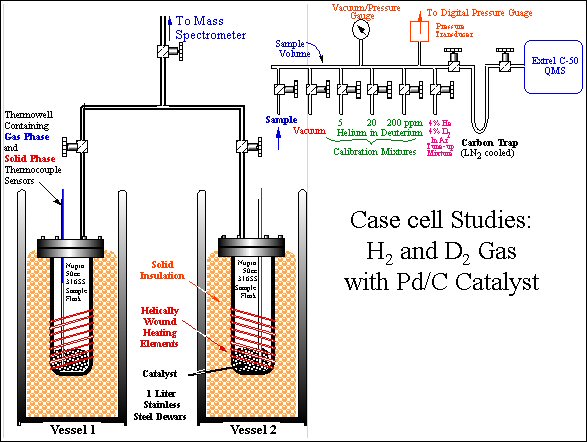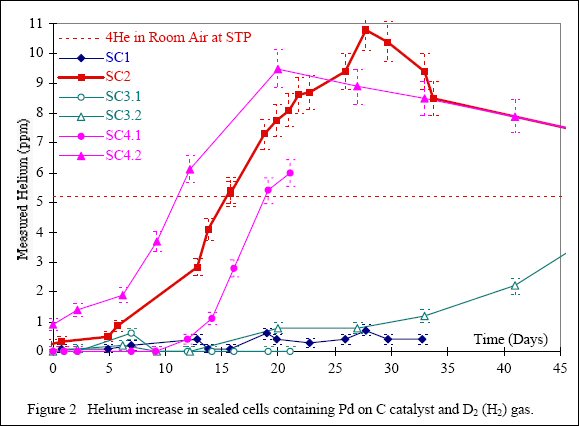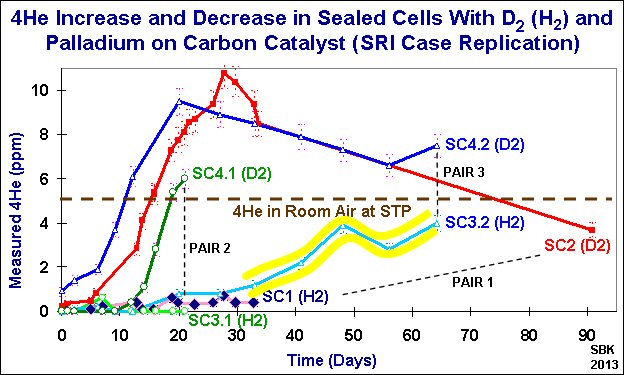1998 SRI International Hydrogen LENR Experiment Produces Helium-4

June 19, 2013 – By Steven B. Krivit –
New Energy Times has discovered that a 1998 light-hydrogen gas LENR experiment performed at SRI International, in Menlo Park, Calif., unexpectedly produced a significant amount of helium-4. [DAP errMsgTemplate=”” isLoggedIn=”N”] According to the deuterium-deuterium cold fusion hypothesis, this result is impossible. [/DAP] Otherwise-identical deuterium-gas experiments conducted in parallel also produced helium-4.
The researchers who performed this set of experiments have published and presented this data for 14 years; however, they obscured this particularly anomalous result. This surprising data, which clearly indicated production of helium-4 in a light-hydrogen gas experiment, contradicted the deuterium-deuterium cold fusion theories of their colleague Peter Hagelstein.
The context for the significance of this observation of helium-4 production with light-hydrogen gas goes back to the very beginning of the “cold fusion” story.
At the Dallas, Texas, American Chemical Society national meeting on April 12, 1989, reporters asked “cold fusion” co-discoverer Stanley Pons about the “obvious control experiment of running with all conditions identical but with normal water rather than heavy water.”
Pons knew that an admission of excess heat with light water would directly contradict his and co-discoverer Martin Fleischmann’s working hypothesis of deuterium-deuterium cold nuclear fusion.
Pons reluctantly admitted to reporters that the experimental data he and Fleischmann had accumulated suggested that they had observed excess heat in light-water (H2O) electrolytic cells as well as in heavy-water (D2O) cells.
[DAP errMsgTemplate=”” isLoggedIn=”N”]
Login or Subscribe to remove this notice
Professional Journalism – LENR Facts
Original online content only at New Energy Times
[/DAP]
[DAP errMsgTemplate=”” isLoggedIn=”N”]
_____ Article continues for subscribers. Click here to subscribe. _____
[/DAP]
[DAP errMsgTemplate=”” isLoggedIn=”Y”]
“A baseline reaction run with water is not necessarily a good baseline reaction,” Pons said. “We do not get the expected baseline experiment; we do not get the total blank experiment.”
Throughout the last 24 years, the interest in light-hydrogen LENRs has ebbed and flowed, based on the reported success or failures of experiments, as well as the popularity or lack of popularity of certain theoretical ideas.
By the year 2000, only a handful of researchers in the field were still doing experimental work in light-hydrogen LENRs. At the time, the dominant belief among LENR researchers was that heavy-water Pons and Fleischmann-type electrolytic cells caused fusion of two deuterium atoms to create helium-4 along with significant amounts of calorimetrically measured excess heat.
On the other hand, the majority of researchers also believed that light-water cells produced little or no accompanying excess heat and that they produced transmutations of heavy elements.
The driving force behind the research in 2000, as well as today, was a search for a potential new source of clean nuclear energy. Although the more complex heavy-element transmutations were instructive in understanding the mechanism of LENRs, the LENR researchers thought they had less financial incentive to spend limited funds for what they believed were economically useless light-hydrogen LENR systems.
In 2000, a team of researchers at SRI International, led by Michael McKubre, an electrochemist, presented a paper at the 8th International Conference on Cold Fusion in Lerici, Italy. McKubre showed data from several important experiments that he said confirmed the 1989 deuterium-deuterium cold nuclear fusion hypothesis of Pons and Fleischmann.[1] One of these data sets was from the 1994 experiment “M4.” Years after the experiment took place, McKubre gradually changed, added and deleted data points and values in an apparent effort to prove the poorly supported cold fusion hypothesis.
The SRI International group also reported the results of an experiment it performed in 1998; it was a replication of a palladium catalyst on activated-carbon LENR gas-phase experiment originally developed by Lester Case. Francis Tanzella was the primary researcher who worked on that set of experiments. The experiments were performed in pairs of H2 and D2 gas in side-by-side stainless steel chambers, as shown below in McKubre’s slide presentation.

Pair of Case gas cells, H2 and D2 side-by-side, from SRI replication. (Slide credit: M. McKubre)
Air from the active as well as control cells was evacuated before starting the experiments. All cells showed a starting value of helium-4 close to zero. The SRI researchers reported in their paper that they performed 16 runs in paired, D2 versus H2, cells. They displayed data for three of these matched pairs. The three D2 cells showed a rapid initial increase in helium-4. One of the H2 cells showed a slow helium-4 rise that increased from near zero to 4 ppm. However, the researchers did not label their runs to show which runs were with D2 and which were with H2. Distinguishing which pairs are which in the graph, as published by SRI below, is impossible.

Graph published by SRI researchers showing three pairs of experimental runs with D2 and H2 gas in the Case replication experiments.
SRI researchers also did not display the full timescale of collected data for two of the runs. A decade ago, New Energy Times obtained an editable file of this graph (containing all of the experimental data that SRI had collected for these six runs) from McKubre in order to make a simpler graph for a publication. McKubre explained how to edit the file to fit the publication layout. The timescale of the graph, as received, went up to 45 days.
The Full Data Set
In preparation for another publication recently, New Energy Times went back to the original file, which contained the complete data for the six experimental runs, and changed the colors to make the curves more readable. We found that the timescale went all the way out to 95 days instead of just the 45 days that had been published by SRI. This revealed the continuation of the two longest runs.
The graph presented below displays the full timescale and depicts the paired runs in similar colors. Run SC3.2 is the most technically exciting run because it shows a light-hydrogen experiment with helium-4 production going up to 4 ppm. According to the deuterium-deuterium cold fusion hypothesis, this result is impossible.

Full data set shows helium rise in normal-hydrogen gas LENR experiment.
The data file also provided the specific time and quantitative measurements of helium-4 concentration in ppm for each data point. These data make the proper pairings much easier to distinguish and correctly identify. The researchers terminated the first pair of runs at different times but terminated the second and third pairs simultaneously.

Matched pairs of hydrogen and deuterium runs and production of helium-4.
New Energy Times attempted to confirm the correct identification of the matched pairs with Tanzella. However, even though he operated the experiments, he wrote that he could not recall which pairs belonged to which isotope.
New Energy Times asked Tanzella to check his records. In the morning of May 20, he wrote that he “went back to the original notebooks from 15 years ago” and said that the pairings were based on the use of different catalysts, not hydrogen isotope.
New Energy Times asked Tanzella why the original figure caption said that the graph was labeled as if it displayed pairs of D2 and H2.
Tanzella replied that the graph was labeled D2 (H2) because “all of the cells started out (pretreatment) with H2.”
In the afternoon of May 20, New Energy Times asked Tanzella why the text of the paper stated that SRI had run pairs of D2 and H2 and why the diagram of the schematic indicated that the pairs were of D2 and H2.
“As for paired cells,” Tanzella wrote, “SC1 and SC2 were run simultaneously as a pair, as were SC3 and SC4. Also, SC1 and SC2 had the same catalyst, as did SC3 and SC4. I don’t have access to the original data for SC1 and SC2. I apologize if my extrapolation from the later results may be misleading.
“Unfortunately, our original notebooks are in Records Retention and would take weeks to retrieve and analyze.”
Conclusions
New Energy Times does not understand why Tanzella, with the assistance of McKubre:
– failed to distinguish between D2 and H2 runs in their graph.
– displayed, according to recent statements by Tanzella, five D2 runs and only one H2 run (this appears to be inconsistent with their previously stated practices involving presentation of such data).
– labeled the graph “D2 (H2)” when, according to recent statements by Tanzella, H2 was merely used as a pretreatment for all runs (another inconsistency).
– ran pairs, according to recent statements by Tanzella, of different catalysts rather than matched pairs of D2 versus H2, as they wrote in the 2000 paper.
– made no mention of using pairs of different catalysts in the earlier 2000 paper.
Ironically, SRI promoted this set of experiments as one of its most significant claimed validations of deuterium-deuterium “cold fusion,” and it was one of the most well-known and widely cited helium-4 experiments in the entire field.
1. Michael McKubre, Francis Tanzella, Paolo Tripodi and Peter Hagelstein, “ The Emergence of a Coherent Explanation for Anomalies Observed in D/Pd and H/Pd Systems; Evidence for 4He and 3He Production,” 8th International Conference on Cold Fusion, Lerici (La Spezia), Italy: Italian Physical Society, Bologna, Italy, (2000)
Questions? Comments? Submit a Letter to the Editor.

